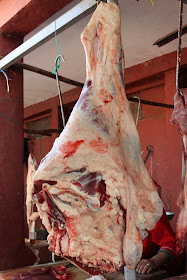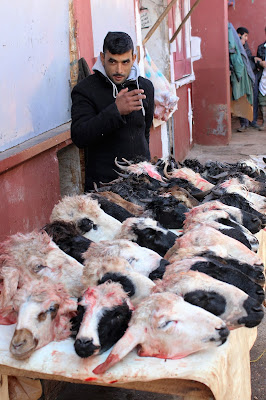We were back with our driver Aziz, who had driven us from Fes to the Sahara, and from the Sahara to Marrakech.
We stopped several times for photos. It doesn't look very mountainous, does it?
The area around Marrakech is similar to the high desert of Southern California:
Our drive to Imlil was on a windy, narrow road with no guard rails to slow our possible flight over the side and down the cliff, but at least it was scenic--pretty much the kind of road we'd been on for most of the trip since leaving the Sahara.
Our first stop was the Saturday Berber Market in a tiny town named Amizmiz a few miles before Imlil. Parking was crazy. There were probably several thousand people crammed into a very small area. Cars were fighting with donkeys and old, broken down buses for space on the road and in the dirt parking lots.
Inside the market, we began taking photos as we walked, but we quickly discovered that the locals didn't like cameras. We had to ask permission, and then we had to try to avoid getting people in the photos. A few times we paid a few dirham (1 dh = 10 cents) for a photo. Unlike the souks in the big cities, this place wasn't necessarily catering to tourists. We would not have been comfortable here without Aziz. Actually, we weren't all that comfortable even with Aziz. Our cameras drove the locals away, and so photography was unpopular.
Fair enough.
The Moroccan bread looks so yummy, but it's mediocre at best:
There were piles of all kinds of fruits and vegetables:
. . . a wide variety of herbs:
. . . more varieties of dates and figs than I knew existed:
. . . all kinds of dried beans and grains:
. . . tubs of salt crystals and bottles of juice (No, I have no idea what the two items have to do with each other):
There were tables of miscellaneous items--cheap, plastic things you'd find in KMart, such as velour blankets, plastic containers, party favor-style toys, and household items:
We stopped to look at a table full of jewelry, and before I knew it, I was the proud owner of two necklaces and some earrings.
The seller kept telling us it was "Berber silver," although it clearly wasn't. We decided "Berber silver" is a euphemism, similar to how "Berber whiskey" is what the Moroccans call their tea (since good Muslims can't drink alcohol). "Berber silver" is clearly something other than silver. Tin, perhaps?
Buying this jewelry was the fatal flaw of our visit to the Berber market, not because of the quality of the jewelry. I love these necklaces and wear them often. No, it's that our purchase made us targets for every person who had anything to sell. There were not many tourists in the very crowded market, and we were proven buyers. Men, women, and children walking around with trays of cheap necklaces and dozens of bangles on their arms plucked at our sleeves. "Mister, see my pretty necklace," or "Lady, look! Look!" No matter how many times we said no, they kept following us, and our guide did nothing to stop them. Soon they began claiming their wares were "Berber handmade," even though it was the same cheap and unoriginal jewelry we have seen all over the world. Then they began pleading on behalf of their hungry children, and then, "Lady, why you buy from rich man? We poor. Need money more than man with store." Finally, the one that really got us: "You are rich. We have nothing. You MUST help us." It was hard to say no to that amount of guilt being heaped on us. I thought of my tender-hearted sister Chris and was pretty sure she would have left the market with an arm loaded down with fifty bangles. However, we continued on with hard hearts and left without "feeding any of their children," in spite of the fact that they followed us through the remainder of our visit to the market and made us miserable.
Sigh.
On the back wall of the market a series of windows were filled with tagines perched atop a little stove that works somewhat like a Bunsen burner:
Aziz told us that the farmers who bring their wares to sell in the market also bring food for their lunch. They drop it off here at the "cooking station," and for a small fee it is cooked for them. It's a cheap way to eat lunch and is the same idea as a microwave in the company break room.
We were there in the morning, but the cooking had already started, and food aromas coming from this area were just beginning to reach our noses. I would have liked to dip a spoon into each tagine for a buffet lunch.
There were also food stalls where ready-made dishes were available, but not the kind you would get in the U.S.--no hamburgers, chicken nuggets, or french fries. Here, some kind of flat fish was frying in an inch of oil:
The fried fish:
On the left is some fish ready for purchase, laid out on a bed of greens and garnished with lemons. The grilled meat on the right actually looks tasty:
Next, we hit the butchering section, full of all kinds of animals, alive and dead.
Our next bad experience happened when I took a photo of this massive haunch. The butcher got very angry with me and reached towards me as if to take my camera. "Put your camera away!" he shouted in Berber or some other language I didn't speak but could translate based on his pointing and grabbing. Okay, okay!
From then on we went back to asking if we could take pictures.
The man selling goat heads was much more accommodating:
Like the sheep heads we had eaten in Marrakech, these are a popular local dish:
We saw live and dead chickens, ducks, rabbits, pegions, beef, goat, sheep/lamb, turkeys, and fish of many varieties for sale. Do you want to be sure your meat is fresh? Buy it while it's still alive:
Finally, unable to take the jewelry hawkers any longer, we left the market. On our way out, we passed the Donkey Parking Lot. The farmers who live close enough to come on foot haul their goods in by donkey. There were a couple hundred donkeys spending the day together at the market:
With that many donkeys, there are bound to be foot problems. Most donkeys don't need shoes, but they do need to have their hooves trimmed and cared for. This man had set up shop to do just that:
Another man was making the padding placed on the donkeys' backs under the loads they carried. He consented when we asked to take his picture:
He has a great face:
The last thing that happened at the Berber Market added to the craziness of the morning. On our way back to the car, Aziz took us past the place where we had bought the two necklaces. After he began conversing with the owner (not in English), it appeared another man had been designated to "show us the stork nests." We followed him to a spot about 50 yards away from the jewelry stall, and he pointed and this tower, gesticulating wildly and speaking a few words of English but mostly a language we couldn't understand. Yes, we could see the stork nests. Yes, we could see the storks.
We could also see Aziz haggling with the stall owner over what we assumed was his cut of the money we spent there. Everyone involved gets a part of the sale in Morocco. Apparently Aziz wasn't getting enough because they argued for quite a while and we watched the storks as if they were the first ones we had seen.All in all, this was one of my favorite/least favorite stops of the trip. On one hand, it seemed to be a truly authentic experience, and we were quite impressed with the variety of goods and robust market atmosphere. On the other hand, we did not feel welcome and were very uncomfortable much of the time.
Morocco, country of contrasts.
















































I get a little uncomfortable just looking at the pictures. Very negative reactions to photos, I'm amazed you got what you did. I had a couple of people following me most of the time, continually asking me for money the entire time, because I am so rich. I didn't have any small change, and even if I had, I was afraid it would open the flood gates. I was actually kind of happy to get out of there.
ReplyDeleteYep, I would have emptied by pockets, my bank account, then mortgaged my house. I can't resist a hungry child. Therefore, I must NEVER visit this place.
ReplyDeleteThere's something appealing about the tables and bins of fruits, beans, and goat heads. Ok, I'm lying about the goat heads.
Interesting experience. I have felt often like this: that as a tourist I need to stay in my designated tourist space, and not venture out to where the real work of the world happens, but what happened to you is quite extreme. I can see why you were uncomfortable in that setting. (Did you know that your guide was getting a cut, even here?)
ReplyDeleteYes, I think we figured out he got a cut every time we spent money. To his credit, he never pressured us to buy, he just took us around. It seems to be a rather fair system, but it did get irritating, especially when we had to wait while he haggled over his cut (and pretended he wasn't).
Delete